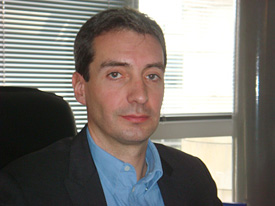Thomson Broadcast — Nicolas Dallery, President
Q. What kind of products or services does your company offer for broadcasters?

Nicolas Dallery
We offer a wide variety of transmission solutions to TV and radio broadcasters. Our equipment covers a multitude of standards for fixed and mobile DTV broadcasting including ATSC/DVB/ISDB-Tb/CMMB. And we supply low (1-100 W), medium (200 W-2 kW), and high power (2 kW-100 kW) VHF/UHF transmitters using air or liquid cooling and both solid state and IOT technologies as appropriate. On the radio side, we offer short-, medium-, and long-wave AM transmitters and support broadcasters converting their networks to Digital Radio Mondiale (DRM)/DAB+ with a variety of digital processing solutions. Thomson Broadcast also provides tower and antennas for the AM market. Beyond the normal hardware, Thomson Broadcast is a full service company, meaning that we offer installation and commissioning services as well as a full after-sales support.
Q. What’s new that you will exhibit at the NAB Show and that TV broadcasters should look for there?
For 2011, we will debut the GreenPower Elite 100 medium power UHF transmitter series. This features the latest 50VDC solid state device technology in the power amplifiers. With this new series, our overall efficiency is increased and we can deliver higher power per amplifier chassis. The Elite 100 UHF is now available up to 2 kW.
We’re also introducing the Elite exciter/re-multiplexer supporting the ISDB-Tb standard for South America. This exciter along with our Elite series DTV transmitters is perfect for new DTV network launches. There’s a unique real-time Digital Adaptive Pre-correction (DAP) feature for excellent stability and quality of the signal regardless of variations in environmental conditions, and that is standard on the Thomson Elite ISDB-Tb transmitters. An embedded SNMP agent and a Web server are included to monitor the equipment.
Finally, there’s the new cost-effective multichannel Elite 10 Repeater system. In the multichannel configuration, this can support 10 W per channel with up to six RF channels of capacity. To help drive costs down, this configuration uses a pooled power supply arrangement and a single (optional) Web server for remote configuration and maintenance. The Elite 10 repeater is available with our very efficient echo canceller, and can even be configured for adjacent channel operation with our patent-pending RF combiner design.
Q. How is your new product offering different from what’s available on the market?
Energy costs are going to continue rising, so we have been focusing on new products and technologies that are the most energy efficient to save our customers money. Our DCX Paragon MSDC-IOT and GreenPower Elite solid state transmitters offer really impressive efficiency gains and provide broadcasters with the lowest cost of ownership. This efficiency focus is something we have been working on for a few years now: for instance, the DCX Paragon MSDC-IOT based DTV transmitter debuted at the 2003 NAB Show and has since gained more than 80-percent market share with more high-power amplifiers deployed than all our competitors combined.
The GreenPower Elite 1000 high-power UHF solid state debuted last year at the NAB Show. By using the latest 50VDC LDMOS devices it features the highest power density in the industry, with up to 14 kW ATSC in a single transmitter cabinet. We have now embedded the same highly efficient amplifier technology into our GreenPower Elite 100 medium-power UHF transmitter shown at NAB2011.
And beyond offering the most efficient amplifier design, all of our DTV transmitters feature our Emmy Award-winning Digital Adaptive Pre-correction (DAP) that has become the standard in the broadcast industry. Simply put, DAP ensures that both linear and non-linear distortions are fully corrected, for the best possible signal quality and highest SNR. DAP saves time and money and ensures the best possible signal coverage.
Q. How has your company been affected by the current economic situation and what are you doing to get through it?
I guess we are very much like a lot of companies in that we are affected by customer demand for greater value, quicker return on investment, and more efficiency in operation. The only appropriate response to that is to bring products out that satisfy those requirements. It’s fortunate for us that as a company we are heavily focused on R&D, and that we took the right decisions some years ago to develop a range of technologies that the market really wants now. There was a period awhile back when energy savings and operational efficiency were almost an optional extra for some buyers, but now they are at the top of the agenda, and if a manufacturer can combine them together with great quality, robustness and top service, you are in a good place as a company. However, it’s vital to keep innovating in search of greater efficiency because it’s the only way to provide what the industry wants, and with our recent corporate restructure we are able to put even more of our resources into developing the products people will be looking for in five years from now, and beyond.
Q. Where are you based, and how many employees do you have? Anything else we should know about your company?
Thomson Broadcast is headquartered just outside Paris, France. And we have production facilities in Southwick, MA (US); Turgi, Switzerland; and Schifferstadt, Germany. We maintain the largest fleet of broadcast transmission equipment worldwide, with over 50,000 active units, and we have more than 300 employees. Thomson Broadcast has a new dynamism after Technicolor reorganized its Thomson brand as two distinct entities — Thomson Broadcast and Thomson Video Networks. We are very well set up now to present a clear identity to the market, and even better positioned to continue the great tradition of innovation that has seen the Thomson name associated with industry-shaping developments since the earliest days of broadcasting.
The professional video industry's #1 source for news, trends and product and tech information. Sign up below.
